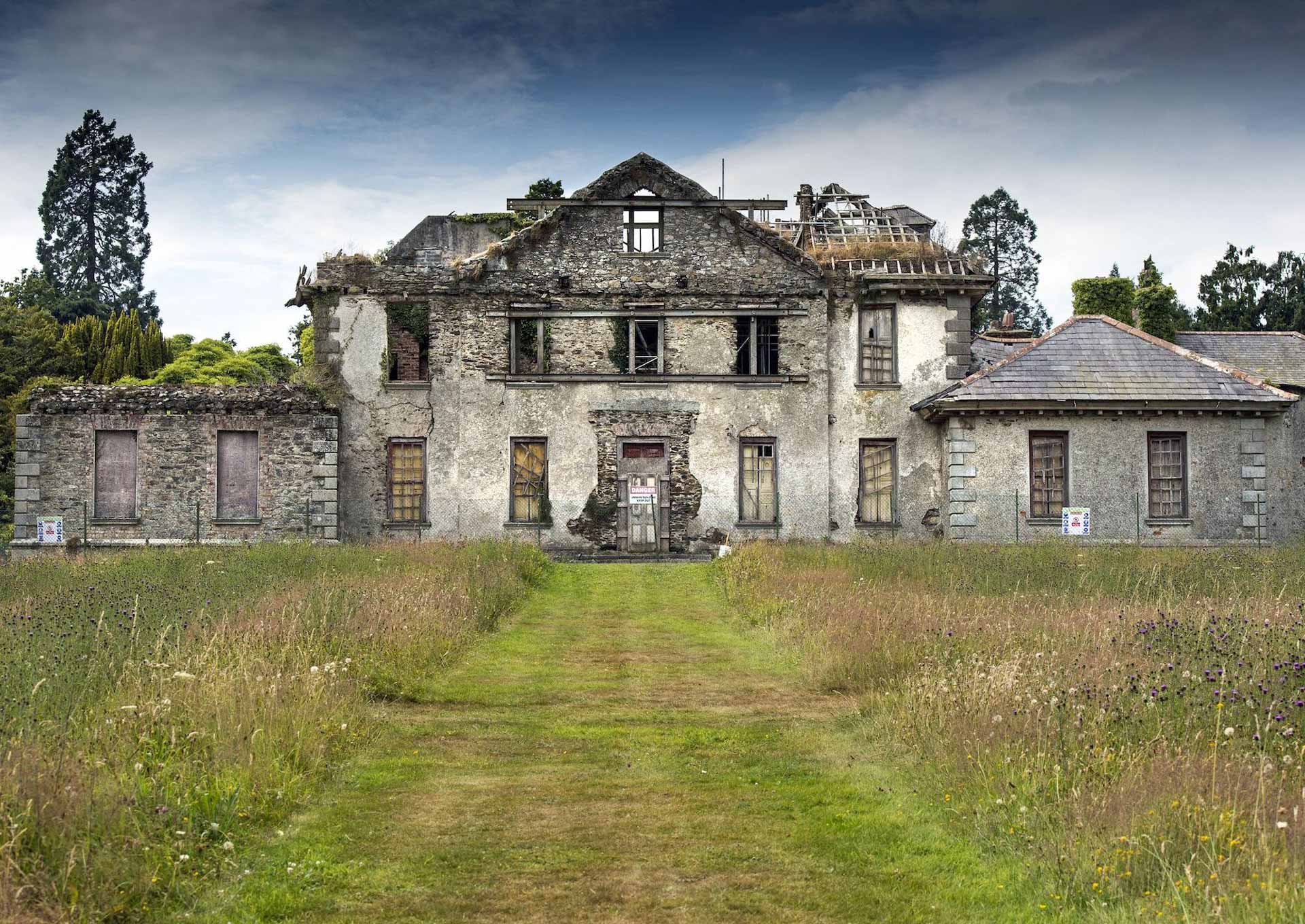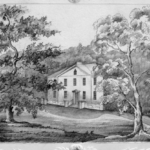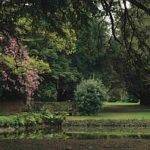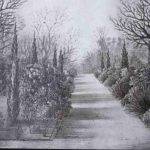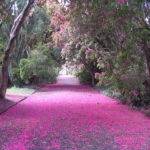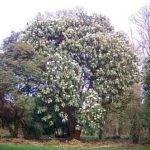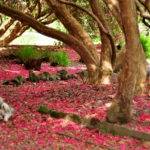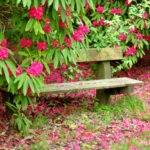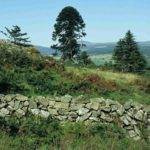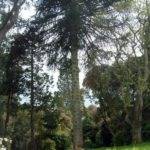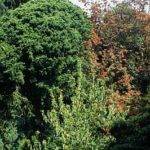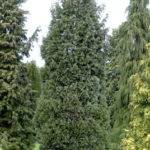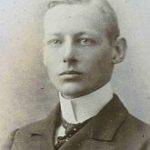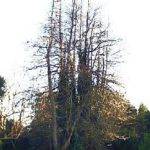The first evidence of buildings at Kilmacurragh formed part of a monastic community.
This had been founded by Saint Mochorog, a Briton of royal birth, who established a hermitage here in the early seventh century (his feast day is December 23rd). The abbey survived to the early sixteenth century, and was lost to the dissolution of Irish and British monasteries by Henry VIII. The foundations of the old abbey still exist and lie beneath the present Chinese garden east of the Pond Vista.
Thomas Acton I (d. 1671) came to Ireland as part of Oliver Cromwell’s invading army, and in lieu of wages was granted a substantial parcel of land in the area, including the ruins of Saint Mochorog’s Abbey. The monastery orchard (on the site of the present walled garden) was still extant in 1708 and appears on an estate map dating from that time.
Scroll down for a full history of the Kilmacurragh Estate, or use the submenu to the right to navigate the sections.
The House and Early Garden
Thomas Acton II (1655-1750) had the old abbey buildings torn down in 1697 and, from the stone salvaged, he built a fine, perfectly proportioned Queen Anne house to the design of the noted architect, Sir William Robinson (1643-1712), whose best-known work is the Royal Hospital Kilmainham. The five-bay mansion was one of the first unfortified houses of the time in County Wicklow, and is one of the few remaining (albeit in a ruinous state) early panelled houses in Ireland. Comprising five reception rooms and eight bedrooms, the house was perched on a hill facing east, making it a chilly place to be in winter.
Kilmacurragh House was then surrounded by a formal Dutch-style landscape park, following the fashions of the period, and elements of this, such as the remains of canals, great avenues, and sweeping vistas, survive in the present garden. Thomas Acton II was also responsible for the Deer Park, an area of forty acres, carved into primeval oak and alder forest, completely surrounded by a six-foot deep ha-ha, and the old paddock walls that now surround the visitor carpark.
It was during this period that Kilmacurragh’s famous yew walk (known locally as the Monk’s Walk) was planted along an old road that served as a pilgrims’ route from the abbey at Kilmacurragh to nearby Glendalough.
Jane Parsons and the Birr Castle Connection
Thomas Acton’s son, William Acton (1711-1779), married Jane Parsons of Birr Castle in 1736, and during their tenure the estate was further embellished. To celebrate their wedding, a two-mile long beech avenue was planted in 1736 and fragments of this survive today. In 1750, his wife received a premium of £10 from the Royal Dublin Society for the planting of ‘foreign trees’ and in the following decades trees were planted within the demesne in tens of thousands. The old stable yard, first built in 1703, was substantially altered in 1762 to create the present courtyard with its fine coach houses.
William and Jane Acton had six children and their second son, Thomas Acton III (1742-1817) inherited the estate in 1779. He changed the name of the estate from Kilmacurra to West Aston in 1750, a situation that lasted for over a century. His wife Sidney earned premia from the Dublin Society for growing small plantations and with this money she bought rare and exotic trees.
William Acton and the Great Famine
Her eldest son was Lt. Col. William Acton (1789-1855), and he was Thomas Acton IV’s father. William Acton was a benevolent landlord, and he organised several famine projects on the estate to stave off starvation, not only of local people, but also of labourers from County Mayo. The restoration of the ha-ha around the Deer Park and by the front lawns, and the building of two projecting and overlapping single-storey wings to the house, were carried out in 1848 as part of this relief effort. William is credited with building the walled garden during the 1820s, with its orangery (the latter still existed till the early twentieth century) and glasshouse ranges. In 1838 he levelled an area to the south of the main lawn, and during this work a huge quantity of bones were unearthed. The tennis court (still extant) lies on the old monastery graveyard. The unearthed bones were placed beneath a stone cairn near the fishpond below the house.
Many of the exotic trees planted by William Acton were supplied by Edward Hodgins, who founded his famous nursery in nearby Dunganstown in 1780. A number of trees supplied to the estate by this nursery between 1820 and 1840 still exist including the Madeiran holly, Ilex perado, a weeping cedar of Goa, Cupressus lusitanica ‘Glauca Pendula’, the unaccountably rare olive relative Picconia excelsa and Fraxinus excelsior ‘Monstrosa’. Nothing is known about the origin of Fraxinus excelsior ‘Monstrosa’ though it is presumed to have originated at Dunganstown. The cultivar was not named until 1872, though the Kilmacurragh tree was 1 foot tall in 1840, and was 10 feet 9 inches tall in 1877. It is now a substantial tree and grows on the Double Border lawn near the walled garden.
Thomas and Janet Acton: the Victorian Years
When Thomas Acton inherited the Kilmacurragh Estate in 1854, the house and gardens were already over 150 years old. Some time between then and the 1870s he reverted the estate’s name back to Kilmacurragh. Alas, his Irish must not have been so good. Up to 1750 the anglicised spelling was Kilmacurra, deriving from Cill mo Churra meaning the church or cell of Saint Mochorog. Thomas Acton’s new Kilmacurragh, meaning ‘the church of the plain’, is quite incorrect, but it is too late to turn back now since two cultivars carry this spelling.
By 1854 the landscape park at Kilmacurragh, with its quaint Dutch ponds, canals, avenue, and vistas must have been very mature, though by that period it was also seen as old fashioned and quite colourless. Thomas and his sister Janet swept away many eighteenth-century features while incorporating others into a new, much enlarged garden.
One of Kilmacurragh’s best-loved features, the Broad Walk to the rear of the house, was laid out at this time. Typically Victorian, Broad Walks survive in several Irish gardens and examples are found at Glanleam, Fernhill, and Kilmacurragh. All are impressively wide walks lined with equally impressive trees and shrubs.
David Moore, curator of the Royal Botanic Gardens, Glasnevin began advising the Actons from about 1854, and from that time on a remarkable collection of mostly wild origin plants was assembled at Kilmacurragh. The late nineteenth century enjoyed a golden era of botanical exploration, and through the Moore family the latest discoveries of these famous plant hunters reached Kilmacurragh, forming a remarkable collection of mostly wild-origin plants.
Kilmacurragh’s Broad Walk was planted with alternating rows of Irish yew, Taxus baccata ‘Fastigiata’, the crimson flowered Rhododendron ‘Altaclerense’ and the lower-growing Rhododendron ‘Cunningham’s White’. The rhododendrons were layered by Janet Acton herself and the walk was planted in the early 1870s. Today this walk is one of the garden’s most magical features, especially in April when the fallen blossoms of towering rhododendrons transform the walk below into a scarlet carpet underfoot.
Sir Joseph Dalton Hooker’s Sikkim Collections
The gardens became an unofficial annexe of Glasnevin, growing plants that could not cope with the cold climate and the shallow, heavily alkaline conditions of that Dublin garden. Following his father’s death in June 1879, Sir Frederick Moore took up the role of garden advisor at Kilmacurragh. Together Thomas Acton and Frederick Moore created the finest private plant collection on the island of Ireland.
It was through David Moore that Sir Joseph Hooker’s collections from the Sikkim Himalaya (1849) reached here, and formed the basis of what was to become Europe’s most complete collection of Rhododendrons from Sikkim, Bhutan, and Nepal. Many of these Rhododendrons have survived to the present day and have formed giant trees that give a dazzling floral display every spring.
In March 1867 Moore could write to Hooker that he saw eleven kinds of his (Hooker’s) rhododendrons growing happily at Kilmacurragh including the blood red R. thompsonii, R. edgeworthii, R. wallichii, R. barbatum and the magnificent R. falconeri.
The Monkey-Puzzles on Westaston Hill
Tom Acton had a rule of thumb, which was to plant three of every important tree or shrub. One was planted where visiting plantsmen told him it would thrive, another where he thought it would survive, and the last where it would unquestionably not survive.
Examples of the latter may be seen on the brow of Westaston Hill that overlooks the house and estate. To this day a line of exotics, like Himalayan rhododendrons, mighty North American conifers, and Chilean trees, all planted by Tom Acton’s gardeners, still grow on this wind swept site. Most are in ragged order and battered because of their exposed positions – except for two fine monkey puzzles. This tree inhabits the high Andes of Chile where it is exposed to the same raging winds. In this case, a tree planted in a situation where he was told it would positively not grow, did survive; indeed it thrived.
A Trial Ground for New Trees
Tom Acton ran Kilmacurragh like a private botanic garden, and kept detailed records of his experiments. He trialed many, many plants for hardiness, and the results of his successes and failures are noted in his trial notes. He certainly understood the needs of his plants; on one of his surviving hand-written lists dating from July 1893 he wrote of Protea cynaroides, “I think (it) may do well under (a) wall, keep him dry.” Following this tip the king protea has recently been planted at Kilmacurragh in a relatively dry spot near the walled garden. During his time at Kilmacurragh several trees were cultivated in the open air for the very first time in the British Isles and Ireland, most notably Ceratonia siliqua, the magnificent Laureliopsis philippiana from Chile and Nothofagus moorei, one of the most beautiful of the southern beeches. Tom Acton got his plant of the latter from Kew from where it had been introduced from its native eastern Australia in 1892. Augustine Henry noted in The Trees of Great Britain and Ireland that it was 18 feet high in 1906. This rare southern beech was named for David Moore’s brother, Charles, who, following an early career at the Trinity College Botanic Garden, became Director of Sydney Botanic Gardens. He discovered the tree in New South Wales and, no doubt, Sir Frederick Moore was pleased to see it established at Kilmacurragh. Alas, it no longer grows here, though there are fine trees in nearby Mount Usher.
Two cultivars were selected at Kilmacurragh while Thomas and Janet gardened here. The best-known of these, Chamaecyparis lawsoniana ‘Kilmacurragh Variety’, is a slim, fastigiate tree with a habit resembling the Italian cypress. An enormous specimen (perhaps the original) grows along the old estate entrance avenue in a double-sided avenue of monkey puzzles. The second, a cockscomb Japanese cedar, Cryptomeria japonica ‘Kilmacurragh’ forms a domed-shaped bush with fasciated juvenile foliage. The original tree grows in the Victorian Double Borders and both Kilmacurragh cultivars originated before 1900.
Thomas and Janet Acton were passionate gardeners and saw many exotic plants in their natural habitats, particularly those from North America. At a time when the Irish aristocracy and gentry took Grand Tours to study art and architecture, the Actons departed from the norm and spent their time looking at trees and shrubs in their native haunts. By the 1860s, Tom and Janet had travelled the world. The highlight of their tour was when they trekked on pony back through the Yosemite Valley in California, where they had the opportunity to study trees like the giant redwoods and the western yellow pine, Pinus ponderosa. Decades later their final resting place was beneath a western yellow pine in Kilmacurragh’s eighteenth-century Deer Park.
Captain Charles Annesley Ball-Acton and the Great War
When Thomas Acton died on August 25th 1908, his 32 year-old nephew, Captain Charles Annesley Acton then succeeded to Kilmacurragh. Born in Peshwar, India in 1876, he was educated following family tradition at Rugby and the Royal Military College at Sandhurst. In 1896 he joined the Royal Welsh Fusiliers and served with the regiment in Malta, Crete, Hong Kong, India and Burma. Following his uncle’s death Charles resigned his commission and settled for a gentleman’s life on the family estate. Back in Wicklow he became Justice of the Peace and High Sherriff for Wicklow, positions held by several of his ancestors. He continued to develop the estate and arboretum and his closest friends included Augustine Henry and Sir Frederick Moore. Moore continued to advise at Kilmacurragh and supplied many newly introduced plants from the nursery at Glasnevin.
With the outbreak of the Great War in August 1914, Charles and many of the gardeners at Kilmacurragh headed for the battlefields on the French Front. On September 25th 1915, Charles Acton, while trying to assist a fellow soldier, was mortally wounded by an explosion at Loos. He was only 39.
Kilmacurragh then passed to his only surviving brother, Major Reginald Thomas Ball-Acton, father of the late Charles Acton (music critic for the Irish Times). On May 22nd 1916, just eight months after his brother’s death at Loos, Reginald was killed in Action in Ypres. Few of the gardeners came home from the war. Thus, in eight years Kilmacurragh had three consecutive owners inflicting death duties amounting to 120% of the value of the estate. This placed enormous financial pressures on the family and, after two centuries, the Actons left Kilmacurragh House. Before the war eleven men and two boys maintained the grounds. Following the death of Charles and Reginald, the gardens were maintained single-handedly by the old Head Gardener.
There are other reminders of this sad period at Kilmacurragh. In the walled garden grow a line of mature maidenhair trees, Ginkgo bilboa, planted just over a metre apart. Tradition has it that this was a nursery bed and since the garden staff believed that the war would last only a few weeks, the young trees were left in-situ, with the belief that they would be placed in their permanent positions when staff returned that autumn. No one came home from those bloody battlefields, and the maidenhair trees still grow in their nursery positions. Kilmacurragh’s tragic history is well known, and the fallen crimson blossoms of the ancient rhododendrons on the Broad Walk have been said by one visitor to be as symbolic as the Flanders poppies.
